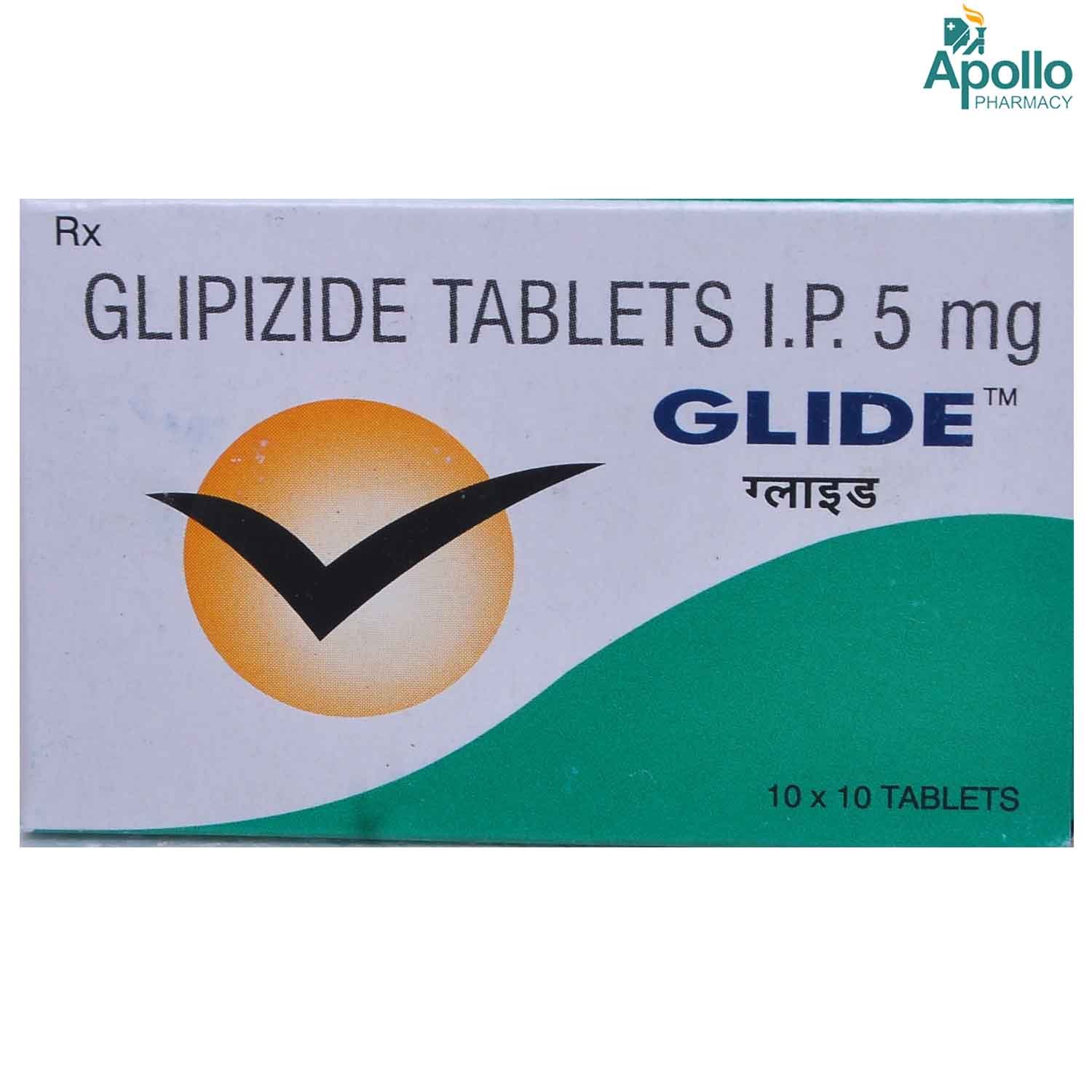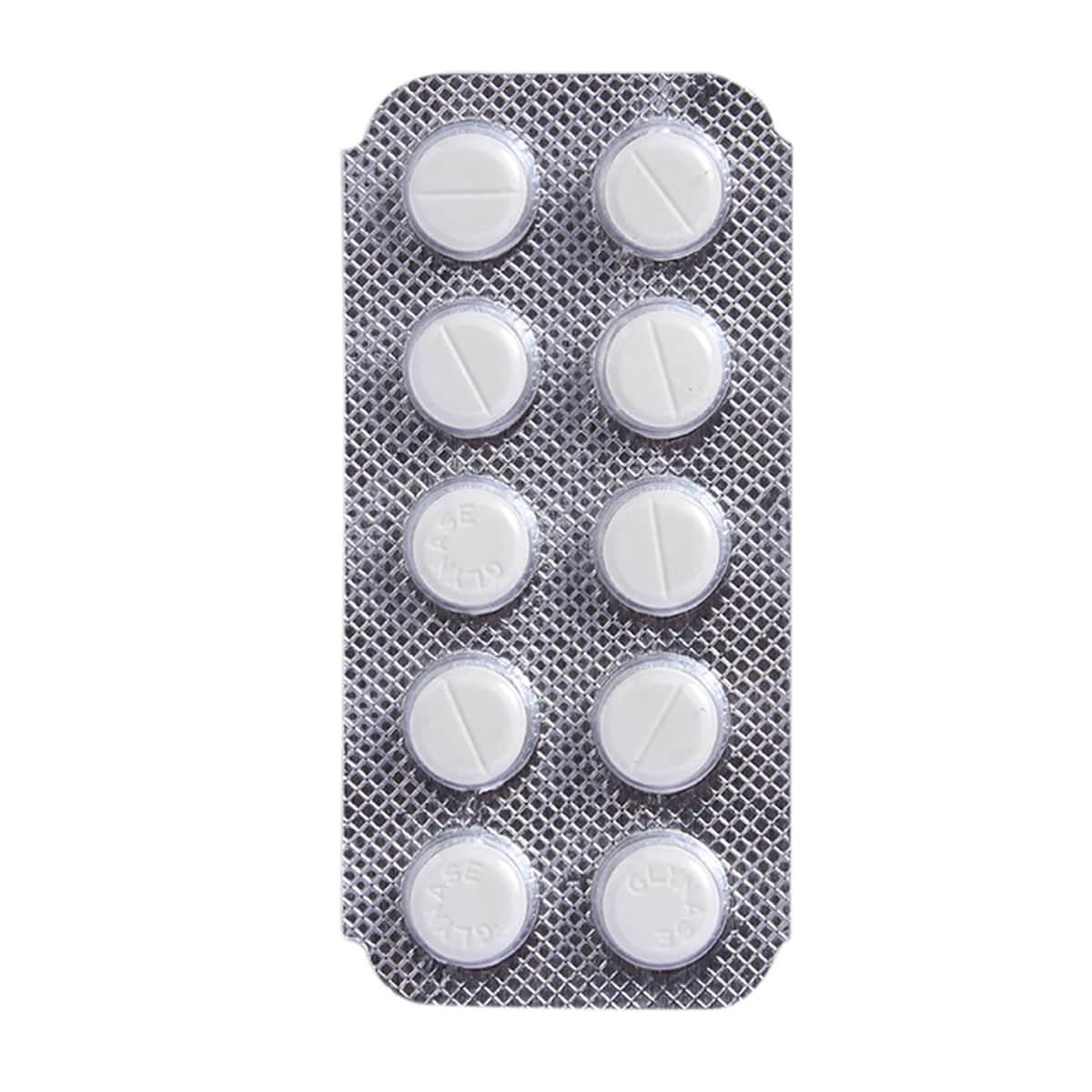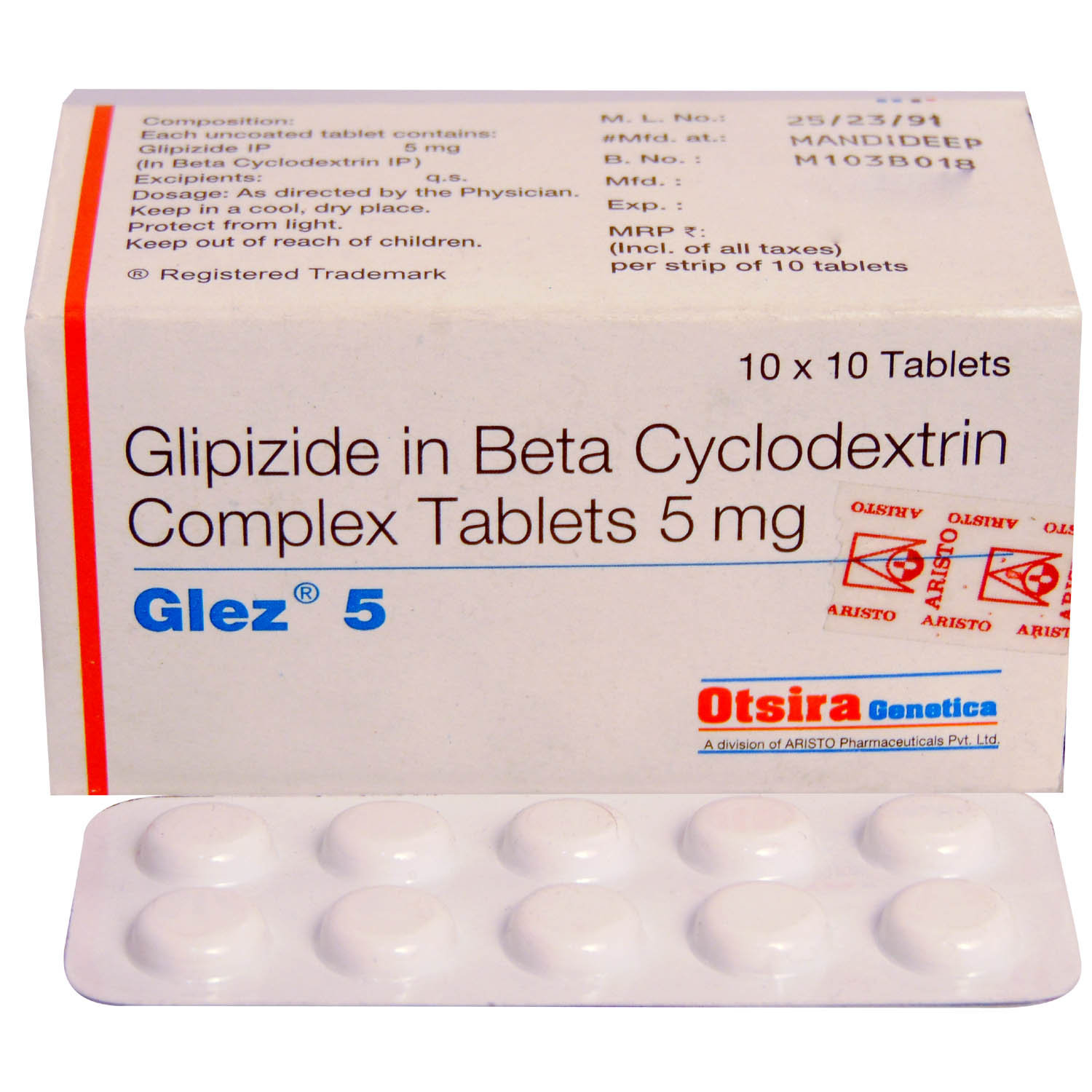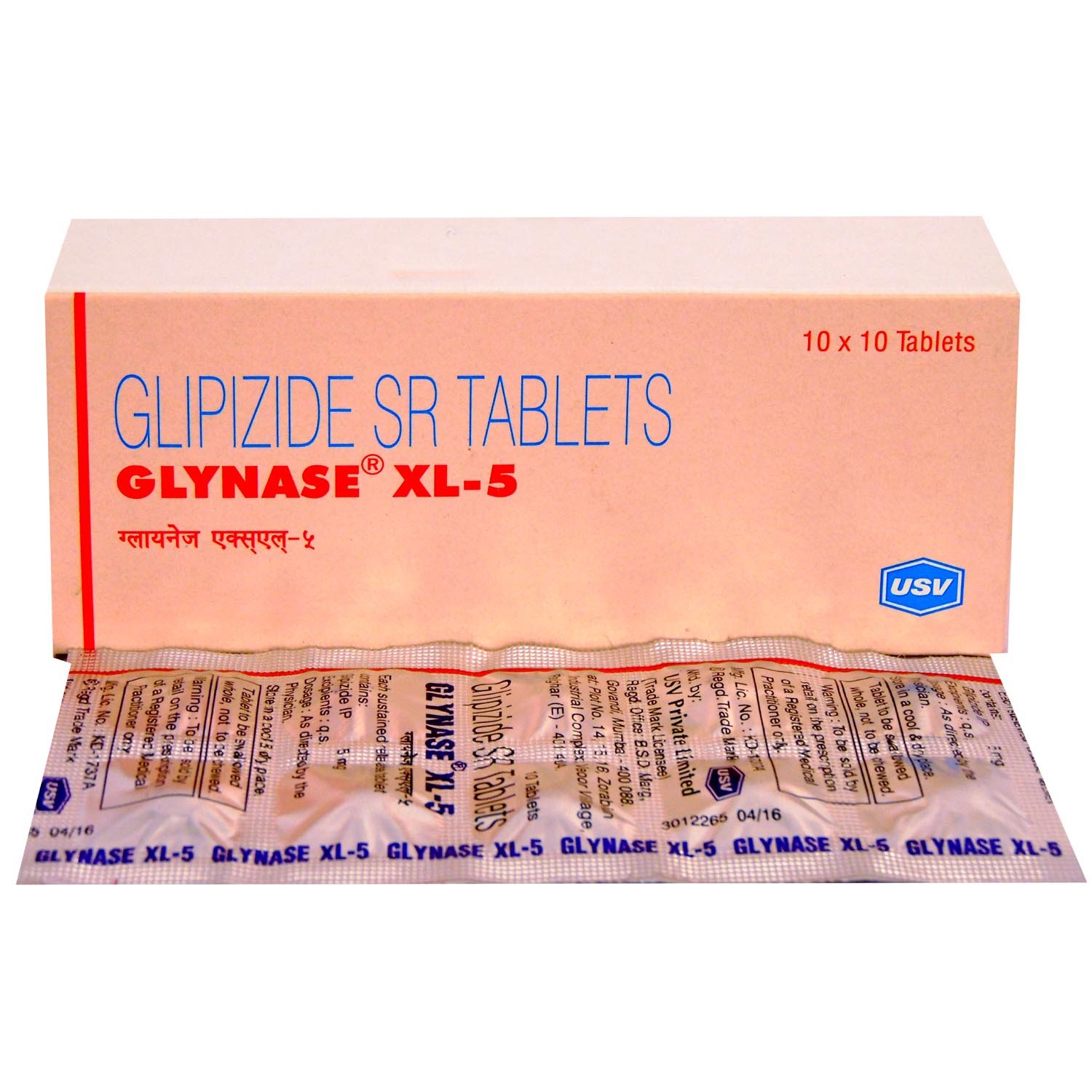GLIBETIC 5MG TABLET


MRP ₹4.2
(Inclusive of all Taxes)
₹0.6 Cashback (15%)
Provide Delivery Location
Online payment accepted
 Prescription drug
Prescription drugWhats That
Composition :
Manufacturer/Marketer :
Consume Type :
Return Policy :
Expires on or after :
About GLIBETIC 5MG TABLET
GLIBETIC 5MG TABLET belongs to the group of antidiabetic medicines called 'sulfonylureas' used to treat type-2 diabetes mellitus when diet and exercise alone cannot control their blood sugar levels. Type-2 diabetes mellitus is also known as non-insulin-dependent diabetes. Diabetes is a condition in which blood glucose levels are above normal.
GLIBETIC 5MG TABLET contains 'Glipizide' which works by increasing insulin production by stimulating insulin secretion from the beta cells of the pancreas, thereby reducing high blood glucose (sugar) levels.
You are advised to take GLIBETIC 5MG TABLET for as long as your doctor has prescribed it for you, depending on your medical condition. In some cases, you may experience certain common side effects such as hypoglycemia (low blood glucose levels), nausea, diarrhoea, and stomach pain. Most of these side effects do not require medical attention and will resolve gradually over time. However, you are recommended to consult your doctor if you experience these side effects persistently.
GLIBETIC 5MG TABLET is not effective in people with type 1 diabetes or for treating serious hyperglycemia (high blood glucose levels). Consult your doctor before taking GLIBETIC 5MG TABLET if you are pregnant or breastfeeding. GLIBETIC 5MG TABLET is not recommended for children. Avoid alcohol consumption while taking GLIBETIC 5MG TABLET as it might increase side effects. GLIBETIC 5MG TABLET may cause dizziness and drowsiness, so drive only if you are alert. Inform your doctor about all the medications you are taking and your health condition to rule out any unpleasant side effects.
Uses of GLIBETIC 5MG TABLET
Directions for Use
Medicinal Benefits
GLIBETIC 5MG TABLET belongs to the group of antidiabetic medicines called 'sulfonylureas' used to treat type-2 diabetes mellitus. GLIBETIC 5MG TABLET is prescribed for the condition of type 2 diabetes when diet and exercise alone cannot control their blood sugar levels. GLIBETIC 5MG TABLET works by increasing insulin production by stimulating insulin secretion from the beta cells of the pancreas, thereby reducing high blood glucose (sugar) levels.
Storage
- Always wear loose-fitting clothes which are suitable for your activity.
- Include the diet containing fruits like watermelon, grapes, bananas and green leafy vegetables.
- Drink plenty of water stay hydrated.
- Avoid moving more and staying in hot sun.
- Inform your doctor about the nausea and discuss possible alternatives to the medication or adjustments to the dosage.
- Divide your daily food intake into smaller, more frequent meals to reduce nausea.
- Opt for bland, easily digestible foods like crackers, toast, plain rice, bananas, and applesauce.
- Avoid certain foods that can trigger nausea, such as fatty, greasy, spicy, and smelly foods.
- Drink plenty of fluids, such as water, clear broth, or electrolyte-rich beverages like coconut water or sports drinks.
- Use ginger (tea, ale, or candies) to help relieve nausea.
- Get adequate rest and also avoid strenuous activities that can worsen nausea.
- Talk to your doctor about taking anti-nausea medication if your nausea is severe.
- Record when your nausea occurs, what triggers it, and what provides relief to help you identify patterns and manage your symptoms more effectively.
- Reduce fluid intake 2-3 hours prior to bedtime.
- Limit alcohol and caffeine as they can increase urination and affect bladder health.
- Maintain sleep hygiene.
- Eat a low-salt and healthy diet.
- If you experience low blood sugar levels, inform your doctor. They will assess the severity and make recommendations for the next actions.
- Your doctor will assess your symptoms, blood sugar levels, and overall health before recommending the best course of action, which may include treatment, lifestyle modifications, or prescription adjustments.
- Follow your doctor's instructions carefully to manage the episode and adjust your treatment plan.
- Make medication adjustments as recommended by your doctor to prevent future episodes.
- Implement diet and lifestyle modifications as your doctor advises to manage low blood sugar levels.
- Monitor your blood sugar levels closely for patterns and changes.
- Track your progress by recording your blood sugar levels, food intake, and physical activity.
- Seek further guidance from your doctor if symptoms persist or worsen so that your treatment plan can be revised.
- Please inform your doctor about joint pain symptoms, as they may adjust your medication regimen or prescribe additional medications to manage symptoms.
- Your doctor may prescribe common pain relievers if necessary to treat joint discomfort.
- Maintaining a healthy lifestyle is key to relieving joint discomfort. Regular exercise, such as low-impact sports like walking, cycling, or swimming, should be combined with a well-balanced diet. Aim for 7-8 hours of sleep per night to assist your body in repairing and rebuilding tissue.
- Applying heat or cold packs to the affected joint can help reduce pain and inflammation.
- Please track when joint pain occurs and any factors that may trigger it, and share this information with your doctor to help manage symptoms.
- If your joint pain is severe or prolonged, consult a doctor to rule out any underlying disorders that may require treatment.
- Hydrate your body: Drink enough water to prevent dehydration and headaches.
- Calm Your Mind: Deep breathing and meditation can help you relax and relieve stress.
- Rest and Recharge: Sleep for 7-8 hours to reduce headache triggers.
- Take rest: lie down in a quiet, dark environment.
- Cold or warm compresses can help reduce tension.
- Stay Upright: Maintain good posture to keep symptoms from getting worse.
- To treat headaches naturally, try acupuncture or massage therapy.
- Over-the-counter pain relievers include acetaminophen and ibuprofen.
- Prescription Assistance: Speak with your doctor about more substantial drug alternatives.
- Severe Headaches: Seek emergency medical assistance for sudden, severe headaches.
- Frequent Headaches: If you get reoccurring headaches, consult your doctor.
- Headaches with Symptoms: Seek medical attention if your headaches include fever, disorientation, or weakness.
Drug Warnings
GLIBETIC 5MG TABLET is not effective in people with type 1 diabetes or for treating serious hyperglycemia (high blood glucose levels). Do not take GLIBETIC 5MG TABLET if you are allergic to any of its contents. Take GLIBETIC 5MG TABLET with caution if you have kidney and liver problems. Consult your doctor if you are pregnant or breastfeeding. Avoid alcohol consumption while taking GLIBETIC 5MG TABLET as it might increase side effects.
Drug-Drug Interactions
Drug-Drug Interactions
Login/Sign Up
Co-administration of Glibetic 5mg Tablet with Gatifloxacin may affect blood glucose levels. Both low blood glucose and, less frequently, high blood glucose have been reported.
How to manage the interaction:
Although there is a possible interaction, Glibetic 5mg Tablet can be taken with Gatifloxacin if prescribed by the doctor. Consult the prescriber if you experience symptoms such as nervousness, confusion, headache, dizziness, drowsiness, tremors, nausea, hunger, weakness, perspiration, palpitation, rapid heartbeat, increased urination, increased thirst, and increased hunger. Maintaining blood glucose levels is advised. Do not discontinue the medications without consulting a doctor.
Co-administration of Norfloxacin with Glibetic 5mg Tablet may occasionally affect blood glucose levels. Both Hyperglycemia (high blood sugar levels) and Hypoglycemia (low blood glucose) have been reported.
How to manage the interaction:
Although there is a possible interaction Glibetic 5mg Tablet can be taken with Norfloxacin if prescribed by the doctor. Consult the prescriber if you experience symptoms of low blood sugar such as dizziness, drowsiness, headache, nervousness, confusion, tremors, nausea, hunger, weakness, perspiration, palpitation, and rapid heartbeat or symptoms of high blood sugar like increased urination, increased thirst, or increased hunger. Maintaining blood glucose levels is advised. Do not discontinue any medications without consulting a doctor.
Co-administration of Miconazole may increase the blood levels and effects of Glibetic 5mg Tablet leading to hypoglycemia (low blood glucose levels).
How to manage the interaction:
Although there is a possible interaction, Glibetic 5mg Tablet can be taken with miconazole if prescribed by the doctor. Consult the prescriber if you experience symptoms of low blood sugar such as dizziness, drowsiness, nervousness, headache, confusion, tremor, nausea, palpitation, hunger, weakness, perspiration, and rapid heartbeat. Monitoring of blood glucose levels is advised. Do not discontinue the medications without consulting a doctor.
Taking Levofloxacin with Glibetic 5mg Tablet may affect blood glucose levels. Both high blood sugar levels or and, less frequently, low blood glucose have been reported.
How to manage the interaction:
Although there is a possible interaction Glibetic 5mg Tablet can be taken with Levofloxacin if prescribed by the doctor. Consult the prescriber if you experience dizziness, drowsiness, headache, nervousness, confusion, tremors, nausea, hunger, weakness, perspiration, palpitation, and rapid heartbeat, increased urination, increased thirst, or increased hunger. Monitoring of blood glucose levels is advised. Do not discontinue the medications without consulting a doctor.
Taking Grepafloxacin with Glibetic 5mg Tablet may affect blood glucose levels. Both high blood sugar levels or and, less frequently, low blood glucose have been reported.
How to manage the interaction:
Although there is a possible interaction Glibetic 5mg Tablet can be taken with Grepafloxacin if prescribed by the doctor. Consult the prescriber if you experience symptoms of low blood sugar such as dizziness, drowsiness, headache, nervousness, confusion, tremors, nausea, hunger, weakness, perspiration, palpitation, and rapid heartbeat or symptoms of high blood sugar like increased urination, increased thirst, or increased hunger. Monitoring of blood glucose levels is advised. Do not discontinue the medications without consulting a doctor.
Taking Cinoxacin with Glibetic 5mg Tablet may affect blood glucose levels. Both high blood sugar levels or and, less frequently, low blood glucose have been reported.
How to manage the interaction:
Although there is a possible interaction Glibetic 5mg Tablet can be taken with Cinoxacin if prescribed by the doctor. Consult the prescriber if you experience symptoms of low blood sugar such as dizziness, drowsiness, headache, nervousness, confusion, tremors, nausea, hunger, weakness, perspiration, palpitation, and rapid heartbeat or symptoms of high blood sugar like increased urination, increased thirst, or increased hunger. Monitoring of blood glucose levels is advised. Do not discontinue the medications without consulting a doctor.
Co-administration of Ofloxacin and Glibetic 5mg Tablet can sometimes have an effect on blood glucose levels.
How to manage the interaction:
Although combining Ofloxacin and Glibetic 5mg Tablet can lead to an interaction, they can be taken on a doctor's advice. If you experience any symptoms of hypoglycemia (headache, dizziness, sleepiness, nervousness, confusion, shaking, nausea, hunger, weakness, sweat, palpitation, and rapid heartbeat) or hyperglycemia (increased thirst, hunger, and urination), consult a doctor. Keep an eye on your blood glucose levels. Do not discontinue any medications without consulting a doctor.
Taking Enoxacin with Glibetic 5mg Tablet may affect blood glucose levels. Both high blood sugar levels or and, less frequently, low blood glucose have been reported.
How to manage the interaction:
Although there is a possible interaction Glibetic 5mg Tablet can be taken with Enoxacin if prescribed by the doctor. Consult the prescriber if you experience symptoms of low blood sugar such as dizziness, drowsiness, headache, nervousness, confusion, tremors, nausea, hunger, weakness, perspiration, palpitation, and rapid heartbeat or symptoms of high blood sugar like increased urination, increased thirst, or increased hunger. Monitoring of blood glucose levels is advised. Do not discontinue the medications without consulting a doctor.
Taking Ciprofloxacin with Glibetic 5mg Tablet may affect both high blood sugar levels or/and, less frequently, low blood glucose.
How to manage the interaction:
Although there is a possible interaction Glibetic 5mg Tablet can be taken with Ciprofloxacin if prescribed by the doctor. However, consult the doctor if you experience symptoms such as headache, dizziness, drowsiness, nervousness, confusion, tremor, nausea, hunger, weakness, excessive sweating, and rapid heartbeat, increased thirst, increased hunger, and increased urination. Do not discontinue the medications without consulting a doctor.
Taking Moxifloxacin with Glibetic 5mg Tablet may affect blood glucose levels. Both high blood sugar levels or and low blood glucose.
How to manage the interaction:
Although there is a possible interaction Glibetic 5mg Tablet can be taken with Moxifloxacin if prescribed by the doctor. Consult the doctor if you experience dizziness, headache, rapid heartbeat, increased urination, increased thirst. Do not discontinue the medications without consulting a doctor.
Drug-Food Interactions
Drug-Food Interactions
Login/Sign Up
Diet & Lifestyle Advise
- Include foods rich in healthy carbohydrates and fibre, fruits, whole grains, and vegetables in your diet.
- Try eating food at regular intervals. Do not skip meals. Also, try not to overeat.
- Follow a healthy diet and walk for at least 45minutes to complement treatment with GLIBETIC 5MG TABLET.
- Maintain a healthy weight by exercising regularly.
- Rest properly, and avoid stress by doing meditation or yoga.
Side Effects of GLIBETIC 5MG TABLET
- Hypoglycemia (low blood glucose levels)
- Nausea
- Diarrhoea
- Stomach pain
Habit Forming
Therapeutic Class
All Substitutes & Brand Comparisons
RX
Out of StockGlucolip 5mg Tablet
Wallace Pharmaceuticals Pvt Ltd
₹5.11
(₹0.46 per unit)
21% COSTLIERRX
Out of StockGlucotrol Tablet 20's
Jenburkt Pharmaceuticals Ltd
₹11.5
(₹0.52 per unit)
36% COSTLIERRX
Out of StockGlipitis 5mg Tablet
₹6.7
(₹0.6 per unit)
57% COSTLIER
Product Substitutes
Author Details
We provide you with authentic, trustworthy and relevant information
Drug-Diseases Interactions
Drug-Diseases Interactions
Login/Sign Up
Some sulfonylurea medications should not be used to treat diabetic ketoacidosis in individuals who are in or out of the coma. Additionally, these medications shouldn't be the only form of treatment for those with type I diabetes
How to manage the interaction:
Sulfonylureas are contraindicated for the treatment of patients with diabetic ketoacidosis, with or without coma.
Sulfonylureas are broken down in the liver, and their metabolites—some of which have therapeutic potential are eliminated through the urine and feces. Sulfonylureas may cause increased blood drug concentrations in patients with impaired liver and/or renal function, increasing the risk of severe hypoglycemia episodes brought on by these medications. Hepatic impairment may also result in a reduction in gluconeogenic ability, raising the risk even higher. Patients with hepatic and/or renal illness should receive sulfonylurea therapy with caution. It could be necessary to use lower doses and space out dosage adjustments more often. Due to decreased metabolism and/or medication excretion, these patients may experience extended hypoglycemia if it develops while they are receiving therapy
How to manage the interaction:
In patients with impaired kidney function, sulfonylureas may be exposed to higher serum drug concentrations leading to low blood sugar episodes. Therapy with sulfonylureas should be administered cautiously in patients with kidney disease.
Compared to diet alone or diet plus insulin, the use of oral hypoglycemic medicines may be linked to a higher risk of cardiovascular mortality
How to manage the interaction:
The use of oral hypoglycemic agents may be associated with an increased risk of cardiovascular mortality.
FAQs
GLIBETIC 5MG TABLET works by increasing insulin production by stimulating insulin secretion from the beta cells of the pancreas, thereby reduces high blood glucose (sugar) levels.
GLIBETIC 5MG TABLET may sometimes lower the blood glucose levels more than normal, leading to hypoglycemia. Regularly monitor your blood sugar levels while taking GLIBETIC 5MG TABLET. Hypoglycemia symptoms include headache, dizziness, drowsiness, shakiness, faintness, confusion, and visual disturbances.
Hypoglycaemia may occur following prolonged or severe exercise, during illness, alcohol consumption, low food intake, or when GLIBETIC 5MG TABLET is taken along with other antidiabetic medicines.
Maintain a healthy diet by regular intake of carbohydrates such as bread and products containing starch and sugar. Eat your meals regularly, and do not exercise heavily for a longer duration with an empty stomach. Try to keep sugar candies and when you feel symptoms of low blood sugar like excessive hunger, sweating, feeling tired, dizziness, feeling hungry, feeling shaky, and fast heartbeat, immediately take it. This will increase the level of glucose (sugar) in your blood and you will feel normal.
Please do not stop taking GLIBETIC 5MG TABLET without consulting your doctor as it may cause an increase in blood glucose levels. Continue taking GLIBETIC 5MG TABLET for as long as your doctor has prescribed it to you. Do not be reluctant to speak with your doctor if you experience any difficulty while taking GLIBETIC 5MG TABLET.
If you are going to have a major operation or have recently had a serious infection or illness; in such cases, diabetic control may be lost. Consult your doctor if you have any concerns regarding this; your doctor may ask you to temporarily take insulin instead of GLIBETIC 5MG TABLET to control blood glucose levels.
GLIBETIC 5MG TABLET might sometimes affect laboratory test results. Inform the person performing the tests that you are taking GLIBETIC 5MG TABLET.
Do not use GLIBETIC 5MG TABLET if you have a condition called diabetic ketoacidosis (too much acids in the blood) and ever have had an allergic reaction to glipizide.
Drug-Drug Interactions Checker List
- ASPIRIN
- IBUPROFEN
- SITAGLIPTIN
- CANAGLIFLOZIN
- METFORMIN
- INSULIN GLARGINE
- FUROSEMIDE
- METOPROLOL
- LEVOTHYROXINE SODIUM
- WARFARIN
Special Advise
- Regularly monitor blood glucose levels and H1B1AC test (every 3 months) while taking GLIBETIC 5MG TABLET.
- Try not to skip any doses and take GLIBETIC 5MG TABLET for as long as your doctor has prescribed it for you.
Disease/Condition Glossary
Type-2 diabetes mellitus: It is also known as non-insulin-dependent diabetes, a chronic disease that keeps the body from utilizing insulin properly. Diabetes is a condition in which blood glucose levels are above normal. Insulin is the hormone that controls sugar levels in your blood. People with type 2 diabetes either do not produce sufficient insulin or the insulin produced cannot perform its function in the body (insulin resistance). Middle-aged or older individuals are most likely to suffer from type 2 diabetes, hence it is also called adult-onset diabetes. Type 2 diabetes symptoms include lack of energy, tiredness, frequent urination, excess thirst, dry mouth, blurry vision, constant hunger, weight loss, and itchy skin.

Have a query?
Buy best Diabetics products by
Torrent Pharmaceuticals Ltd
Sun Pharmaceutical Industries Ltd
Eris Life Sciences Ltd
Intas Pharmaceuticals Ltd
Lupin Ltd
Micro Labs Ltd
Mankind Pharma Pvt Ltd
Lloyd Healthcare Pvt Ltd
Alkem Laboratories Ltd
Abbott India Ltd
Glenmark Pharmaceuticals Ltd
Cipla Ltd
Macleods Pharmaceuticals Ltd
Wockhardt Ltd
Dr Reddy's Laboratories Ltd
Primus Remedies Pvt Ltd
USV Pvt Ltd
Aristo Pharmaceuticals Pvt Ltd
Emcure Pharmaceuticals Ltd
Alembic Pharmaceuticals Ltd
Ipca Laboratories Ltd
La Renon Healthcare Pvt Ltd
Ajanta Pharma Ltd
Medley Pharmaceuticals Ltd
East West Pharma India Pvt Ltd
Elbrit Life Sciences Pvt Ltd
Corona Remedies Pvt Ltd
Hbc Life Sciences Pvt Ltd
Sinsan Pharmaceuticals Pvt Ltd
Ranmarc Labs
Mitoch Pharma Pvt Ltd
Zydus Healthcare Ltd
Sanofi India Ltd
Akumentis Healthcare Ltd
Fusion Health Care Pvt Ltd
Unison Pharmaceuticals Pvt Ltd
Jubilant Lifesciences Ltd
Novo Nordisk India Pvt Ltd
Tas Med India Pvt Ltd
Blue Cross Laboratories Pvt Ltd
Msn Laboratories Pvt Ltd
Eswar Therapeutics Pvt Ltd
Indoco Remedies Ltd
Q Check Pharmaceuticals
Alteus Biogenics Pvt Ltd
Anthem Bio Pharma
Franco Indian Pharmaceuticals Pvt Ltd
Systopic Laboratories Pvt Ltd
Panacea Biotec Ltd
Zydus Cadila
Biocon Ltd
Edoc Life Sciences Pvt Ltd
Koye Pharmaceuticals Pvt Ltd
Arkas Pharma Pvt Ltd
Diacardus Pharmacy Pvt Ltd
Elinor Pharmaceuticals (P) Ltd
Remedy Life Sciences Pvt Ltd
Saan Labs
Talent India Pvt Ltd
Jarun Pharmaceuticals Pvt Ltd
Capital Pharma
Shrrishti Health Care Products Pvt Ltd
FDC Ltd
Leeford Healthcare Ltd
Nirvana India Pvt Ltd
Elder Pharmaceuticals Ltd
Eli Lilly and Company (India) Pvt Ltd
Glynis Pharmaceuticals Pvt Ltd
Zuventus Healthcare Ltd
Arrient Healthcare Pvt Ltd
Cadomed Pharmaceuticals India Pvt Ltd
Orris Pharmaceuticals
Akesiss Pharma Pvt Ltd
Bal Pharma Ltd
Biochem Pharmaceutical Industries Ltd
Knoll Healthcare Pvt Ltd
Lippon Pharma Pvt Ltd
Morepen Laboratories Ltd
Neucure Lifesciences Pvt Ltd
Opsis Care Lifesciences Pvt Ltd
Wallace Pharmaceuticals Pvt Ltd
Acmedix Pharma Llp
Converge Biotech Pvt Ltd
Erinyle Pharma
Indiabulls Pharmaceuticals Pvt Ltd
Ozone Pharmaceuticals Ltd
Retra Life Science Pvt Ltd
Alvio Pharmaceuticals Pvt Ltd
Geneaid Pharmaceuticals
Heal (India) Laboratories Pvt Ltd
Olcare Laboratories Pvt Ltd
Vasu Organics Pvt Ltd
Kotak Life Sciences
Lakshya Life Sciences Pvt Ltd
Proqol Health Care Pvt Ltd
Sanz Pharmaceuticals
Daylon healthcare pvt Ltd
Mcronus Lifescience Pvt Ltd
Natco Pharma Ltd
Orsim Pharma
Alcohol
Unsafe
You are recommended to avoid alcohol consumption while taking GLIBETIC 5MG TABLET to prevent unpleasant side-effects.
Pregnancy
Unsafe
Do not take GLIBETIC 5MG TABLET if you are pregnant. Your doctor may switch you to insulin injections during yourpregnancy. It is not recommended to take GLIBETIC 5MG TABLET during the last month of pregnancy.
Breast Feeding
Caution
Consult your doctor if you are breastfeeding. Your doctor will decide if GLIBETIC 5MG TABLET can be taken by breastfeeding mothers or not.
Driving
Caution
GLIBETIC 5MG TABLET may cause dizziness and drowsiness, drive, and operate machinery only if you are alert.
Liver
Caution
Dose adjustment may be needed. GLIBETIC 5MG TABLET should be used with caution in patients with liver impairment/liver disease. Please consult your doctor if you have a liver impairment or any concerns regarding this.
Kidney
Caution
Dose adjustment may be needed. GLIBETIC 5MG TABLET should be used with caution in patients with kidney impairment/kidney disease.Please consult your doctor if you have kidney impairment or any concerns regarding this.
Children
Unsafe
GLIBETIC 5MG TABLET is not recommended for children as safety and efficacy have not been established.








_0.jpg?tr=q-85)

